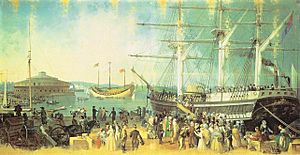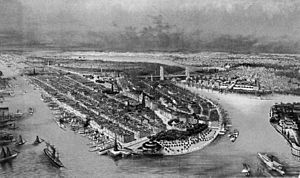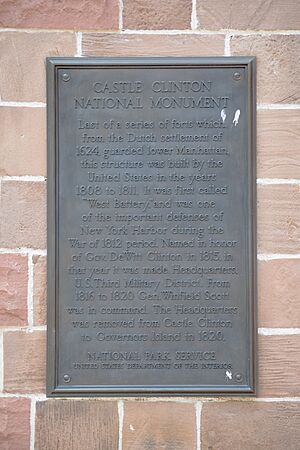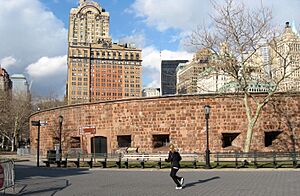Castle Clinton facts for kids
|
Castle Clinton National Monument
Castle Garden |
|
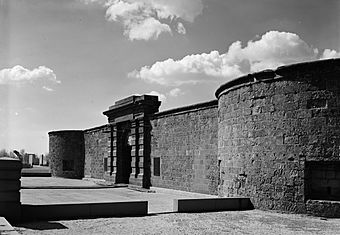
Photo from Historic American Buildings Survey
|
|
| Location | Battery Park, Manhattan, New York |
|---|---|
| Area | 1 acre (0.40 ha) |
| Built | 1808 |
| Architect | John McComb Jr.; Jonathan Williams; U.S. War Department |
| Visitation | 3,471,661 (2022) |
| Website | Castle Clinton National Monument |
| NRHP reference No. | 66000537 |
Quick facts for kids Significant dates |
|
| Added to NRHP | October 15, 1966 |
| Designated NMON | August 12, 1946 |
Castle Clinton is a cool old circular fort in Battery Park, at the very bottom of Manhattan in New York City. It's also been known as Fort Clinton and Castle Garden. This historic building was built between 1808 and 1811.
Castle Clinton has had many different jobs over the years. It started as a fort, but it was never used in a real battle! Later, it became the first place where millions of immigrants arrived in the United States, even before Ellis Island. It also served as a fun entertainment spot, a theater, and even an aquarium. Today, it's a U.S. national monument and a visitor center for the Statue of Liberty.
Contents
A Fort That Never Fought
Castle Clinton was first called the West Battery. It was built on a small artificial island just off the coast of Manhattan. The fort was designed by John McComb Jr. and finished in 1811. It had strong red sandstone walls and 28 cannons.
The fort was meant to protect New York Harbor, especially during the War of 1812. However, the war ended in 1815, and the fort never had to fire its cannons in battle. After the war, it was renamed Fort Clinton, honoring DeWitt Clinton, who was the mayor of New York City.
In 1822, the U.S. Army stopped using the fort. It was then given to New York City.
Castle Garden: A Place for Fun
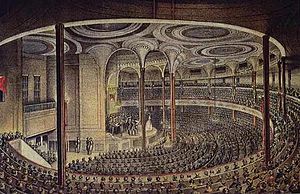
In 1824, the city turned Fort Clinton into a huge entertainment venue called Castle Garden. It became a popular spot for concerts, shows, and parties. Imagine a place with 6,000 seats, a circular promenade, and a roof!
Many famous people visited or performed here. General Lafayette, a hero of the American Revolution, was honored there. U.S. presidents like Andrew Jackson also visited. In 1850, the famous singer Jenny Lind, known as the "Swedish Nightingale," gave her first American concerts at Castle Garden. People paid a lot of money to see her!
The Gateway for Immigrants
From 1855 to 1890, Castle Garden became the first official immigration center in the United States. Before this, new arrivals were often tricked or robbed by dishonest people. Castle Garden was built to help and protect them.
More than 7.5 million immigrants came through Castle Garden. Most of them were from Europe, including Germany, Ireland, Italy, and Sweden. This was a huge number, making up most of the immigrants who came to New York during that time.
How Immigrants Arrived
When immigrants arrived, they first had medical checks on Staten Island. If they were healthy, they took a steamship to Castle Garden. They landed at a special dock that kept them from going into Manhattan before they were processed.
Inside the fort, clerks helped them register and gave them advice about where to go next. There were also places to buy train tickets to other parts of the country. The main waiting area was called the rotunda, and it could hold thousands of people.
Challenges and Changes
Running the immigration center was not always easy. There were often arguments between the city, state, and federal governments about who owned and paid for it. The building also got very crowded and sometimes fell into disrepair.
In 1876, a fire badly damaged the inside of Castle Garden. But it was quickly rebuilt and reopened. Over time, the area around the fort was filled in, connecting the artificial island to the rest of Manhattan.
Moving to Ellis Island
By the late 1880s, Castle Garden was too small and old to handle all the immigrants. There were also complaints about how some officials treated the new arrivals.
In 1890, the federal government decided to build a new, bigger immigration center. They chose Ellis Island for this new facility. Castle Garden closed its doors as an immigration depot on April 18, 1890. The new Ellis Island center opened in 1892.
The New York Aquarium
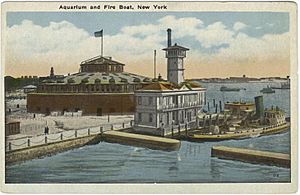
After the immigration center closed, Castle Garden got another new life! From 1896 to 1941, it was home to the first New York Aquarium. The building was changed a lot for this. A tall roof with skylights was added, and the inside was filled with tanks.
The aquarium was very popular, attracting millions of visitors each year. It had a huge central pool and many smaller tanks with all kinds of fish and marine animals. Fresh water came from the city, and salt water was pumped in from the Hudson River.
Running an aquarium in an old fort had its challenges. The skylights sometimes made the water too warm, and the Hudson River water wasn't always salty enough for some fish. Despite these issues, the aquarium was a beloved attraction for many years.
Saving Castle Clinton
In the 1940s, there was a plan to build the Brooklyn–Battery Tunnel. Robert Moses, a powerful city official, wanted to tear down Castle Garden to make way for a new park entrance.
But many people, including historians and former city officials, fought to save the old fort. They believed it was an important part of New York's history. This led to a big debate that lasted for years.
Becoming a National Monument
Thanks to the efforts of many preservationists, the U.S. government stepped in. In 1946, President Harry S. Truman signed a bill making Castle Garden a U.S. national monument. This meant it was protected.
However, the fight wasn't over. It took several more years for the city to officially give the land to the federal government. Finally, in 1950, the National Park Service (NPS) took over Castle Clinton.
Castle Clinton Today
After years of being neglected and partially demolished, Castle Clinton needed a lot of work. The NPS began a major restoration project to bring it back to its original fort appearance. They removed later additions and repaired the old sandstone walls.
The fort reopened in 1975. Today, Castle Clinton looks much like it did when it was first built. The roof over the center is gone, creating an open-air space.
Since 1986, Castle Clinton has served as a visitor center and ticket office for the Statue of Liberty National Monument. Millions of people visit each year to buy ferry tickets to Liberty Island and Ellis Island. Admission to Castle Clinton itself is free, and the NPS offers guided tours. It's a reminder of New York City's long and varied history.
Images for kids
-
Jenny Lind's first U.S. performance at Castle Garden, 1850
-
The New York Aquarium was once housed at Castle Garden (image before 1923).
See also
 In Spanish: Castle Clinton para niños
In Spanish: Castle Clinton para niños


